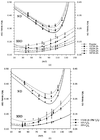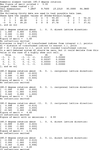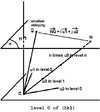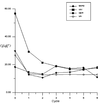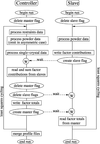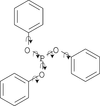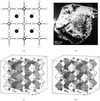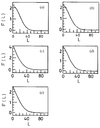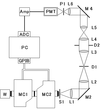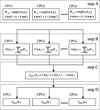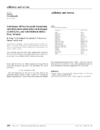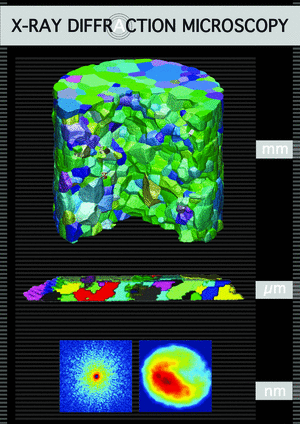issue contents
April 2002 issue

Cover illustration: The crystal structure of titanite, CaTiOSiO4, viewed down the direction of the octahedral TiO6 chains. The full green lines indicate a unit cell of the two-dimensional Ising model, used to predict diffuse scattering intensity observable in layers normal to the chain direction. Ti atoms are shown in green, Ca in light grey, O in blue. The thinner red lines are Si-O bonds, the thick red lines Ti-O1 bonds. Courtesy of T. Malcherek, C. Paulmann, M. C. Domeneghetti & U. Bismayer [J. Appl. Cryst. (2001), 34, 108-113].
research papers
A comparative study of single-line and Rietveld strain–size evaluation procedures using MgO ceramics
Strain–size evaluations from diffraction line broadening for MgO ceramic materials, sintered under various conditions, have been compared using single-line integral-breadth and Rietveld procedures with the Voigt function. X-ray and neutron diffraction data produce similar strain values but markedly different size estimates.
Shining a highly brilliant X-ray beam onto a thin-metal-cap-layer/lipid-bilayers/silicon-substrate system, resonantly enhanced, precisely defined and clearly distinguishable standing-wavefield distributions (modes) are excited. The in-plane structure of the acyl chain ordering is then studied by grazing incidence diffraction under simultaneously excited modes.
The program ROTAX derives non-merohedral twin laws by identifying poorly fitting data during refinement and by transforming their indices by rotations or roto-inversions about possible direct- and reciprocal-lattice directions. Operations that transform these indices to integers are identified as possible twin laws.
The old baffling problem of enumerating all twin laws that are compatible with Mallard's law within given maximum twin index and maximum obliquity knowing the cell data is recast as a Diophantine system of an equality and an inequality. A novel, complete and programmable solution is detailed.
Real-space techniques used in ab initio crystal structure solution of proteins have been optimized for powder diffraction data.
Conoscopic illumination is used in a microscope equipped with a rotating polarizer–circular analyser system and monochromatic light, and the resulting interference pattern is separated into its constituent parts. When the technique is applied to an optically active uniaxial crystal, the so-called Airy's spiral is revealed with high sensitivity, enabling the optical rotation of the crystal to be determined unambiguously.
A description of how to use parallel processing for Rietveld refinement is presented, along with a GSAS implementation.
This paper discusses instrumental aberrations of X-ray diffraction texture (pole figure) measurements conducted in quasi-parallel-beam geometry using a polycapillary X-ray lens. Correction procedures are proposed.
A pinhole high-brilliance SAXS camera with an integrating area detector, based on an X-ray image intensifier that is lens-coupled to a CCD camera, has been used for the acquisition of data over a wide dynamic range of intensity. A correction procedure for the long tail of the point spread function of the detector is presented.
Download citation


Download citation


The crystal structure of the glass-forming molecular liquid triphenyl phosphite [TPP, P(OC6H5)3)] has been solved ab initio at 110 K from powder synchrotron X-ray diffraction data by real-space methods (simulated annealing) followed by rigid-body Rietveld refinements. The hitherto unknown topological features of crystalline TPP, including unusual intermolecular weak C—H⋯O hydrogen-bonding networks, are presented and discussed in the scope of the `glacial state' problem.
The parameters that determine the background contribution in the Porod region are related to the moments of the microscopic density fluctuation.
The temperature dependence of the gyration coefficients of LiIO3 in the presence of multiple reflections has been measured by using the HAUP technique.
Download citation


Download citation


The crystal structure of the relaxor ferroelectric Pb2ScTaO6 has been refined from high-resolution neutron time-of-flight powder diffraction data recorded at various temperatures from 4 to 400 K.
Download citation


Download citation


To facilitate structure solution from powder diffraction data, a structure-envelope option has been implemented in the programs FOCUS (for zeolite framework structures) and Safe (for molecular compounds). The latter allowed the structure of a complex tri-β-peptide with 17 variable torsion angles to be solved.
A method that generates an indexing of area-detector data using a minimum set of reciprocal basis vectors is described and has been implemented in the computer program BAYINDEX. Data of periodic crystals are indexed with three reciprocal basis vectors; data of aperiodic crystals are indexed with four or more reciprocal basis vectors.
Various phasing procedures for xenon-derivatized porcine pancreatic elastase, using data sets measured at three wavelengths, easily accessible on tunable synchrotron beamlines, have been investigated. The importance of highly redundant data in measuring precise anomalous differences is demonstrated and it is shown that, in this case, a single isomorphous replacement anomalous scattering (SIRAS) procedure yields a better phase set than those generated by single anomalous scattering (SAS) or multiwavelength anomalous diffraction (MAD) procedures.
short communications
An intrinsic hook effect was always found to be associated with pseudo-Voigt (p-V) profiles when η was less than 0.328 and the FWHM was small (∼0.02°), where η is the fraction of the Cauchy component and FWHM is the full width at half-maximum. The applicability of the Warren–Averbach (WA) analysis for the case of p-V profiles was thoroughly studied and it was found that a p-V profile with η values ranging from 0 to 1 can be safely subjected to WA analysis, provided that the FWHM of the profile is large enough (2w ≃ 0.378°).
A microspectrophotometer for cryogenic protein crystallography capable of measuring visible absorption spectra of a single crystal at an optical density of up to 5 is described.
The March model and the generalized spherical harmonic description for modelling preferred orientation with pressed molybdite and calcite neutron powder diffraction data, with reference to the reliability of the formulations and their use in correcting intensities for texture bias, are presented.
A method is proposed and preliminary experiments are described for obtaining diffraction-quality macromolecular crystals from nanodroplet crystallization trials. The usual screening process is reduced with respect to the cost, the amount of sample needed, and the time required for crystal growth, greatly contributing to the acceleration of the protein structure determination process.
computer programs
A maximum-entropy analysis program for huge systems, employing parallel data processing and fast Fourier transforms, is presented.
computer program abstracts
A program for automatic indexing of TEM Kikuchi and CBED diffraction patterns and determination of crystallite orientations is described.
addenda and errata
Free 



 journal menu
journal menu








